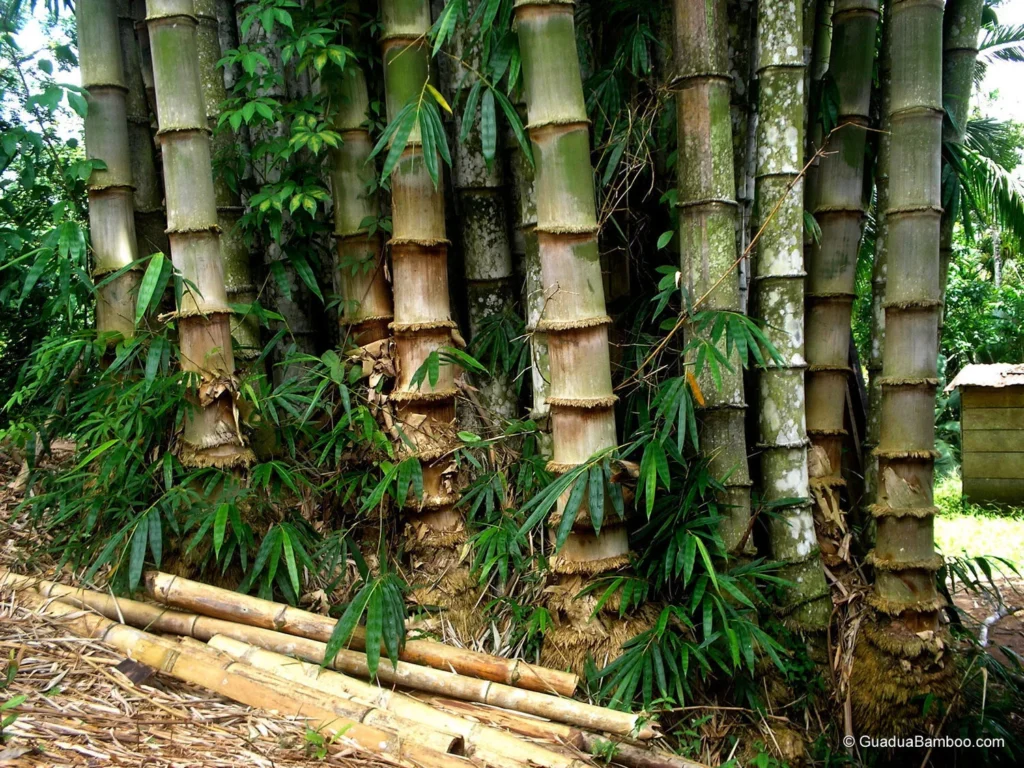
Dendrocalamus asper, commonly known as giant bamboo or dragon bamboo, is one of the most important bamboo species in tropical and subtropical regions. It is recognized for its enormous size, strength, and versatility, making it ideal for use in construction, furniture manufacturing, and environmental restoration.
This species is native to Southeast Asia but has been cultivated widely across the tropics due to its economic and ecological value.
Botanical Classification
- Scientific Name: Dendrocalamus asper (Schult. f.) Backer
- Family: Poaceae (Grass Family)
- Subfamily: Bambusoideae
- Tribe: Bambuseae
- Common Names: Giant Bamboo, Dragon Bamboo, Rough Bamboo, Sweet Bamboo
- Origin: Native to Southeast Asia – found in Indonesia, the Philippines, Thailand, Vietnam, and Malaysia
Morphological Characteristics
Dendrocalamus asper is a clumping (sympodial) bamboo species that forms dense clusters. It is one of the tallest and thickest-walled bamboo types in the world.
Key Features:
- Height: Grows between 15–30 meters under favorable tropical conditions.
- Culm Diameter: Typically ranges from 8–20 cm, with thick walls and large internodes.
- Internode Length: Around 20–60 cm depending on soil and climate.
- Culm Appearance: Cylindrical and straight, often covered with short brown hairs on young shoots. Mature culms are dark green and smooth.
- Branching: Each node has several branches, with one dominant branch.
- Leaves: Lanceolate leaves 15–30 cm long, forming dense foliage.
- Growth Habit: Non-invasive clumping type; shoots emerge close to the parent clump.
Major Varieties
Although Dendrocalamus asper does not have many formally recognized varieties, local cultivars differ in size and shoot quality.
In Indonesia, for example, the “Bambu Petung” variety is famous for its large culms and edible shoots.
Habitat and Distribution
Dendrocalamus asper thrives in warm and humid climates and prefers well-drained loamy soil. It can grow from sea level up to 1,500 meters above sea level.
It naturally occurs in Southeast Asia but has been successfully introduced in countries such as India, China (southern regions), tropical Africa, and South America.
Ideal Conditions:
- Temperature: 20–35°C
- Rainfall: 1200–2500 mm per year
- Soil Type: Loam or sandy soil with good drainage
Economic and Industrial Uses
1. Construction and Structural Applications
Because of its strength and thickness, Dendrocalamus asper is one of the best species for bamboo construction. It is used in building houses, bridges, scaffolding, and bamboo architecture projects. Its flexibility also makes it resistant to earthquake forces.
2. Furniture and Handicrafts
The smooth, durable culms make excellent material for furniture such as chairs, tables, and beds. It is also used in producing handicrafts, bamboo flooring, and musical instruments.
3. Edible Bamboo Shoots
The young shoots are edible and nutritious, commonly consumed in Southeast Asia. They are rich in fiber, vitamins, and antioxidants, with a mild flavor suitable for soups and stir-fried dishes.
4. Paper and Pulp
Dendrocalamus asper has long fibers ideal for paper production. It is used in manufacturing high-quality pulp and bamboo-based paper products.
5. Renewable Energy
The culms and waste biomass can be converted into bamboo charcoal and briquettes, providing a renewable and sustainable energy source.
6. Environmental Rehabilitation
Its dense root system prevents soil erosion, stabilizes slopes, and helps rehabilitate degraded land. It is widely planted in reforestation and agroforestry projects.
Environmental Benefits
- Fast Growth: Culms can reach full height within a few months and mature in 3–5 years.
- Carbon Absorption: Bamboo sequesters large amounts of CO₂ and produces more oxygen than trees of comparable mass.
- Soil Conservation: Deep roots prevent erosion and improve soil structure.
- Sustainability: Harvesting bamboo does not kill the plant since it regrows from existing rhizomes, making it an ideal renewable resource.
Propagation and Cultivation
Dendrocalamus asper rarely produces viable seeds, so it is propagated through vegetative methods such as:
- Culm cuttings: Sections of bamboo culms with one or two nodes are planted horizontally or vertically.
- Rhizome division: Mature rhizomes with new shoots are separated and replanted.
- Branch cuttings: Side branches are used for nursery propagation.
The plant requires full sunlight and moderate moisture for best growth. Fertilization with organic compost or manure can improve culm quality and size.
Challenges and Limitations
- Pest and Decay: Like other bamboo species, untreated culms are vulnerable to borers and fungi. Preservation with borax-boric acid solution or smoke treatment is recommended.
- Transportation: Large culm size makes handling and transport more difficult.
- Irregular Flowering: Flowering events are rare and unpredictable, limiting seed-based propagation.
- Processing Infrastructure: In some regions, industrial-scale bamboo processing is still limited.
Why Dendrocalamus asper Matters
Dendrocalamus asper plays a crucial role in sustainable development due to its wide range of applications, from structural material to food source. It supports green construction, rural livelihoods, and carbon sequestration efforts.
Many sustainable architecture firms in Asia and Latin America now prefer Dendrocalamus asper for eco-resorts, pavilions, and housing due to its strength, availability, and renewable nature.
Conclusion
Dendrocalamus asper is not just the largest tropical bamboo but also one of the most valuable. Its strength, renewability, and ecological benefits make it a cornerstone species for sustainable living. Whether used for construction, food, or land restoration, this giant bamboo stands as a natural solution for a greener and more resilient future.






